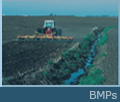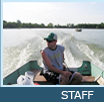        |
|
“You may think that your actions are meaningless and that they won't help, but that is no excuse, you must still act.” .......................................................................... |
|
|
Project Coordinator
Sarah Shimek Duda Sarah received a degree in Animal Ecology and Natural Resource Management from Iowa State University in Ames, IA. She started her career in natural resources as a seasonal private lands technician and firefighter for the U.S. Fish and Wildlife Service. Before coming to the Water Resources Center, she worked as District Technician for Watonwan County Soil and Water Conservation District. Sarah joined the Water Resources Center in 2007 and has really been enjoying herself! As coordinator for the Crystal Loon Mills Clean Water Partnership project, Sarah works with agency partners and private landowners, operators and citizens to enhance education and implement conservation practices to improve water quality in the watershed. She also coordinates the Excess Nutrients Total Maximum Daily Load (TMDL) study that started on Crystal Lake in June 2008 and lends a hand with various other projects and TMDL studies. Graduate Research Assistant
Matt Ribikawskis Matt is from Oak Lawn, Illinois and received his Bachelors of Science degree from St. Norbert College in DePere, WI. Upon completion of his degree, Matt worked 2 years for an environmental consulting firm conducting fish population assessments across the Midwest. Matt is currently a graduate student at Minnesota State University-Mankato, working on his master's degree in biology with an emphasis in water quality & fisheries. As the graduate assistant for the Crystal Loon Mills Clean Water Partnership, Matt's duties include: assisting Sarah with public education and outreach, lake monitoring, County Ditch 56 monitoring, GIS analysis, and landowner/operator communications. For his thesis project, Matt is transplanting submerged aquatic plants (Sago pondweed) into 4 fencing structures throughout Crystal Lake. The project's purpose is to utilize native plants as a way to reduce and remove in-lake phosphorus, to model the number of plants needed to significantly reduce in-lake phosphorus levels, and to provide larval and juvenile fish habitat. Matt has completed his first sampling season during the 2008 summer and will be completing a second sampling season during the 2009 summer. .......................................................................... “The face of the water, in time, became a wonderful book- a book that was a dead language to the uneducated passenger, but which told its mind to me without reserve, delivering its most cherished secrets as clearly as if it uttered them with a voice. And it was not a book to be read once and thrown aside, for it had a new sotry to tell everyday.” - Mark Twain a.k.a Samuel Langhorne Clemens (1835-1910) ..........................................................................
|


